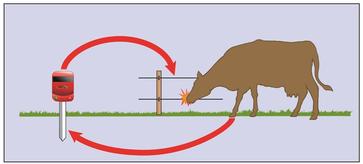hOW ELECTRIC FENCE WORKS
|
An electric fence is based on three components:
|
The fence energiser sends brief, high voltage pulses of electrical current down the fence line. When an animal touches the wire, its body closes the circuit, allowing the electricity to flow down to the ground and back to the energiser. The pulse only lasts for a fraction of a second, so the animal only feels a very brief shock, and moves away from the electric fence immediately.
An electric fence is really a psychological barrier, so you can use fewer materials than a physical barrier, keeping cost to a minimum. It is also completely safe - animals dislike the sensation, deterring them from approaching the fence in the future. Most animals will receive a shock within the first week of the fence being erected; from then on they will avoid it.
An electric fence is really a psychological barrier, so you can use fewer materials than a physical barrier, keeping cost to a minimum. It is also completely safe - animals dislike the sensation, deterring them from approaching the fence in the future. Most animals will receive a shock within the first week of the fence being erected; from then on they will avoid it.

